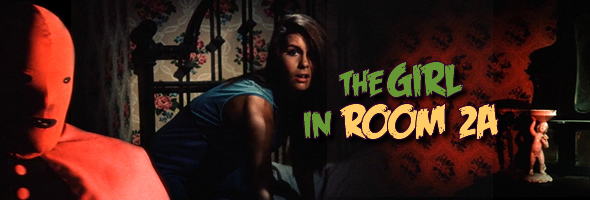
Color, 1974, 84m.
Directed by William Rose
Starring Daniela Giordano, Raf Vallone, John Scanlon, Brad Harris, Karin Schubert, Rosalba Neri, Giovanna Galletti
Mondo Macabro (DVD) (US R0 NTSC) / WS (1.66:1) (16:9)

Color, 1974, 84m.
Directed by William Rose
Starring Daniela Giordano, Raf Vallone, John Scanlon, Brad Harris, Karin Schubert, Rosalba Neri, Giovanna Galletti
Mondo Macabro (DVD) (US R0 NTSC) / WS (1.66:1) (16:9)
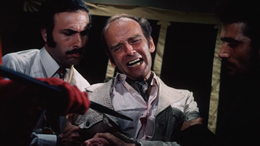 The history of the Italian thriller strain known as the giallo doesn't get much stranger than The Girl in Room 2A, a combination of gothic girl-in-peril shenanigans, red-gloved Euro whodunit, and deeply sleazy American grindhouse schlock. To try to untangle this freaky puppy, you really have to start with the director, William Rose, a name familiar to Something Weird fans as the helmer (or at least cinematic surgeon) behind such titles as Rent-a-Girl, The Smut Peddler, and Professor Lust. With the demand for kinky softcore rapidly disappearing, he hopped over to Italy where he teamed up with the very colorful producer Dick Randall (the man responsible for such films as Pieces and Don't Open Till Christmas) for a pair of films in 1974: Frankenstein's Castle of Freaks (which Randall directed with Rose co-writing) and this film, which was released in the U.S. by Joseph Brenner Associates, sandwiched in between other giallo imports like Autopsy, Torso, and Eyeball. Marketed in its promotional art as an S&M shocker (which isn't totally off the mark), the film didn't make as much o
The history of the Italian thriller strain known as the giallo doesn't get much stranger than The Girl in Room 2A, a combination of gothic girl-in-peril shenanigans, red-gloved Euro whodunit, and deeply sleazy American grindhouse schlock. To try to untangle this freaky puppy, you really have to start with the director, William Rose, a name familiar to Something Weird fans as the helmer (or at least cinematic surgeon) behind such titles as Rent-a-Girl, The Smut Peddler, and Professor Lust. With the demand for kinky softcore rapidly disappearing, he hopped over to Italy where he teamed up with the very colorful producer Dick Randall (the man responsible for such films as Pieces and Don't Open Till Christmas) for a pair of films in 1974: Frankenstein's Castle of Freaks (which Randall directed with Rose co-writing) and this film, which was released in the U.S. by Joseph Brenner Associates, sandwiched in between other giallo imports like Autopsy, Torso, and Eyeball. Marketed in its promotional art as an S&M shocker (which isn't totally off the mark), the film didn't make as much o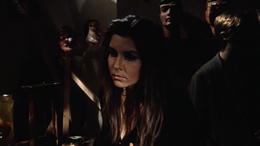 f a splash as its more famous companion films but certainly holds more than a little interest for genre fans today, especially with its nutty cast of familiar faces.
f a splash as its more famous companion films but certainly holds more than a little interest for genre fans today, especially with its nutty cast of familiar faces.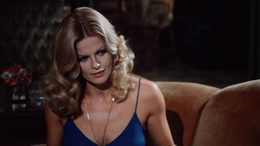 who most of the sect members are, so the only puzzle is figuring out who the red executioner is. The reveal is, ahem, rather unlikely given the physique of this individual in other scenes, so it's best if you don't contemplate it too much. That leaves plenty of time for scenes of Giordano wandering in dark hallways, the police investigating the death of her predecessor, a very unconvincing sex scene with Giordano's body double, and protracted and surprisingly vicious scenes of women being subjected to purification at the end of a whip. Interestingly, both the premise and execution play like an amped-up, Italian version of the same year's House of Whipcord; there must have been something strange in the air in '74. The pounding music score (comp
who most of the sect members are, so the only puzzle is figuring out who the red executioner is. The reveal is, ahem, rather unlikely given the physique of this individual in other scenes, so it's best if you don't contemplate it too much. That leaves plenty of time for scenes of Giordano wandering in dark hallways, the police investigating the death of her predecessor, a very unconvincing sex scene with Giordano's body double, and protracted and surprisingly vicious scenes of women being subjected to purification at the end of a whip. Interestingly, both the premise and execution play like an amped-up, Italian version of the same year's House of Whipcord; there must have been something strange in the air in '74. The pounding music score (comp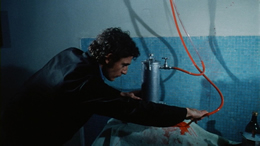 lete with catchy fuzz guitars) is credited to Berto Pisano (Strip Nude for Your Killer), though several passages-- especially the ones involving the cops-- sound an awful lot like library music and wouldn't be out of place in a George Romero film.
lete with catchy fuzz guitars) is credited to Berto Pisano (Strip Nude for Your Killer), though several passages-- especially the ones involving the cops-- sound an awful lot like library music and wouldn't be out of place in a George Romero film.
![]()